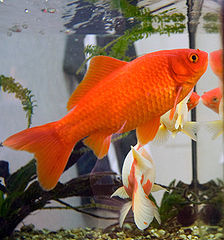One of the most frequently asked questions that customers who are considering their first aquarium ask is how hard is it to clean and maintain an aquarium, particularly if they’re thinking about a saltwater aquarium, because they may have heard that it is very difficult to maintain. If you have a few basic tools, and follow some simple guidelines, then keeping your aquarium clean is easy, and does not require a great deal of time.
If any piece of equipment is a “must” have, then a gravel siphon is it. A gravel siphon will remove water from your aquarium and clean your gravel at the same time. A gravel siphon is a simple device that uses a small diameter flexible tubing that is attached to a larger diameter plastic tube that goes into your  aquarium. The large diameter plastic tube is plunged into your gravel, and removes water at a slow speed that will tumble and clean the gravel without sucking it out of the tank. When the water reaches the small diameter tubing it accelerates and removes only the dirt from the gravel and water. There are two styles of gravel siphon, a simple version like the Lee’s aquarium products Gravel Cleaner, that uses gravity to remove water through a shorter length of tubing into a bucket, or other container. There are also more advance cleaning systems, like the Aqueon Water Changer and the Lee’s Ultimate Aquarium Gravel Vac, that attaches to a sink faucet and uses the water pressure of your tap to draw water through a length of tubing up to 100’ with a venturi attachment that fits any standard faucet. The advantage to the more advanced system is that the flow can be reversed at the faucet end to actually fill your aquarium back up after all the dirt has been removed from the gravel. What could be easier than that! If you have a chlorinated water source you will need to add a water conditioner at the same time. Gravel siphons are available for just about any size aquarium.
aquarium. The large diameter plastic tube is plunged into your gravel, and removes water at a slow speed that will tumble and clean the gravel without sucking it out of the tank. When the water reaches the small diameter tubing it accelerates and removes only the dirt from the gravel and water. There are two styles of gravel siphon, a simple version like the Lee’s aquarium products Gravel Cleaner, that uses gravity to remove water through a shorter length of tubing into a bucket, or other container. There are also more advance cleaning systems, like the Aqueon Water Changer and the Lee’s Ultimate Aquarium Gravel Vac, that attaches to a sink faucet and uses the water pressure of your tap to draw water through a length of tubing up to 100’ with a venturi attachment that fits any standard faucet. The advantage to the more advanced system is that the flow can be reversed at the faucet end to actually fill your aquarium back up after all the dirt has been removed from the gravel. What could be easier than that! If you have a chlorinated water source you will need to add a water conditioner at the same time. Gravel siphons are available for just about any size aquarium.
One of the best inventions to come along in aquarium cleaning products is the magnetic algae cleaner for your aquariums glass or acrylic panels. With the use of two magnets, one inside the aquarium and one outside, you can clean all of you viewing panels without the need to put your hands in the aquarium. The inside magnet has a cleaning surface that removes algae from the inside glass, you simply stick the two magnets together with the aquarium glass in between, then move the outside magnet around until all the algae is gone. This is a simple device, that has dramatically improved the ease and speed that you can clean your glass. In recent years manufacturers have invented a magnet cleaning system that has a floating inside magnet, so you never lose the cleaner to the bottom of the aquarium, which was the downfall to initial models if you moved the outside piece too quickly. Floating magnets like the Magfloat and the Magnavore, are available for most sizes of aquariums in both glass and acrylic safe models.
Just as important as the gravel siphon and the magnet cleaner is following some basic husbandry guidelines to help keep your aquarium clean. Replace your filter cartridges, or filter media, at least once a month, make sure that you are not overstocking and overfeeding your aquarium, and make sure that you keep to a schedule. Small water changes on a weekly or biweekly basis will ensure that your water quality stays at a high level, which will inhibit excess waste build up and algae growth. All of these things are easy to do, and take very little time. If you procrastinate in maintaining the tank, or wait until there is a problem, then correcting issues becomes more difficult and time consuming.

Aquarium keeping should be fun and easy, follow these tips and guidelines, an you should be headed for success.
Until Next Blog,
Dave
 That Fish Blog – Aquarium Advice and Information
That Fish Blog – Aquarium Advice and Information



